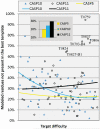Critical assessment of methods of protein structure prediction: Progress and new directions in round XI
- PMID: 27171127
- PMCID: PMC5394799
- DOI: 10.1002/prot.25064
Critical assessment of methods of protein structure prediction: Progress and new directions in round XI
Abstract
Modeling of protein structure from amino acid sequence now plays a major role in structural biology. Here we report new developments and progress from the CASP11 community experiment, assessing the state of the art in structure modeling. Notable points include the following: (1) New methods for predicting three dimensional contacts resulted in a few spectacular template free models in this CASP, whereas models based on sequence homology to proteins with experimental structure continue to be the most accurate. (2) Refinement of initial protein models, primarily using molecular dynamics related approaches, has now advanced to the point where the best methods can consistently (though slightly) improve nearly all models. (3) The use of relatively sparse NMR constraints dramatically improves the accuracy of models, and another type of sparse data, chemical crosslinking, introduced in this CASP, also shows promise for producing better models. (4) A new emphasis on modeling protein complexes, in collaboration with CAPRI, has produced interesting results, but also shows the need for more focus on this area. (5) Methods for estimating the accuracy of models have advanced to the point where they are of considerable practical use. (6) A first assessment demonstrates that models can sometimes successfully address biological questions that motivate experimental structure determination. (7) There is continuing progress in accuracy of modeling regions of structure not directly available by comparative modeling, while there is marginal or no progress in some other areas. Proteins 2016; 84(Suppl 1):4-14. © 2016 Wiley Periodicals, Inc.
Keywords: CASP; community wide experiment; protein structure modeling.
© 2016 Wiley Periodicals, Inc.
Figures








References
-
- Anfinsen CB. Principles that govern the folding of protein chains. Science. 1973;181(96):223–230. - PubMed
-
- Moult J, Pedersen JT, Judson R, Fidelis K. A large-scale experiment to assess protein structure prediction methods. Proteins. 1995;23(3):ii–v. - PubMed
-
- Moult J, Hubbard T, Bryant SH, Fidelis K, Pedersen JT. Critical assessment of methods of protein structure prediction (CASP): round II. Proteins. 1997;(Suppl 1):2–6. - PubMed
-
- Moult J, Hubbard T, Fidelis K, Pedersen JT. Critical assessment of methods of protein structure prediction (CASP): round III. Proteins. 1999;(Suppl 3):2–6. - PubMed
-
- Moult J, Fidelis K, Zemla A, Hubbard T. Critical assessment of methods of protein structure prediction (CASP): round IV. Proteins. 2001;(Suppl 5):2–7. - PubMed

